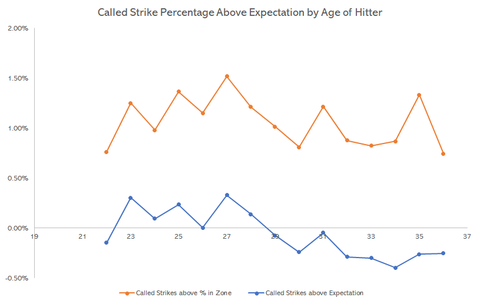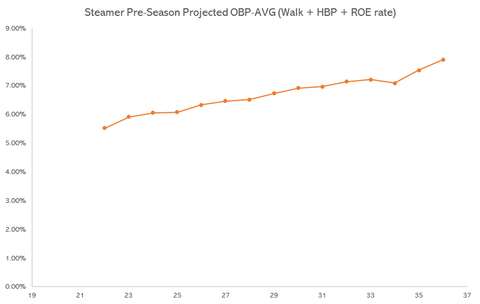In the previous post we showed that umpires gave more calls to veteran pitchers, although part of this was due to veteran pitchers having better accuracy, which likely translates to getting more calls through hitting the catcher's glove. In this post we will focus on hitters, using the same methodology. We start with a chart of called strikes gained versus age:

Older hitters enjoy a slightly smaller strike zone compared to younger hitters. Hitters in the 23-27 age range have about 0.50% more strikes called against them after adjusting for location compared to hitters older than 33. About half of pitches are taken, there are about four pitches in a PA, and one pitch called a strike instead of a ball is worth about 0.16 wOBA, so this hurts younger hitters by about 0.0015 wOBA. Significant but not going to put anyone out of a job.
As with pitchers, this does not confirm age bias, as older hitters are better at taking walks than younger hitters. While I don't have a steamer walk rate prediction for all years since 2015 I do have OBP-AVG which is more or less the same thing (note pitchers are excluded here):

Hitters above 32 draw almost 1.5% more walks than those below 26 and as with pitchers this is once again a much larger difference than could be explained by called strike % alone - older hitters really do have a better command of the strike zone. Is it our "implied walk rate" or age that leads to more strike calls? It turns out age is less important for hitters than pitchers and walk rate is more important, although age still matters a little:
| Under 26 | 26 to 32 | Over 32 | |
| "Walk Rate" < 5% | 0.31% | 0.24% | -0.05% |
| 5-8% | 0.11% | -0.04% | -0.19% |
| "Walk Rate" > 8% | -0.29% | -0.35% | -0.58% |
The strike zone is far more influenced by walk rate in other games than age, with a fairly consistent 0.6% difference between low and high walk rate hitters in our sample, although age still does play a role, with about a 0.25% difference between our under 26 and over 32 cohorts. When better walk rate hitters take the pitch, fewer strikes are called against them than we would expect.
With pitchers, we have the theory that since framing works, hitting the pitcher's glove should also get more calls, and therefore more accurate pitchers should get more calls, if you agree with catcher framing. But with hitters there is no such framing influence on the umpire, and we can't explain away this discrepancy. On the other hand, the influence of hitter walk rate is much lower than pitcher walk rate, so there is less of a discrepancy to explain. There are three possibilities:
- Good walk rate hitters have a better knowledge of what pitches the umpire is likely to call strikes compared to poor walk rate hitters, even after adjusting for the official zone or our model
- The data is bad, and for a small percentage of pitches, the actual location of the pitch in the game was far different than what is shown in the data. This means the associated called strike and official zone predictions are random. Assuming that the information that the hitter took the pitch is accurate but the pitch location is not, better strike zone judgement hitters, when taking the pitch, would be more likely to take a ball than a strike than other hitters
- Good walk rate hitters influence the umpire to get more calls through conversation, reputation, or other means
I believe all three of these are likely true. Starting with the second point, there is simply no way to verify the pitchfx data is right, but I did take a look at pitches that differed the most between the model prediction and the strike call. In a game between COL/LAD on May 10, 2015, I found a call where the reported height above the ground was 6.584 feet that was still called a strike, and in a game between LAA/DET on May 30, 2015, I found a call that was 2.58 feet outside that was reported to be called a strike. It is tough to say how many other errors there are, but there are likely other cases like these, and it is possible this data can't be completely taken at face value.
For the first and third points there is one anomaly that proves that strike zone knowledge and conversation/influence are important parts of getting more calls, the performance of players by position in this metric:
| Strikes Gained Above Predicted | Strikes Above Zone % | Average Steamer "Walk Rate" | Average Age | |
| Catcher | -0.78% | 0.06% | 6.55% | 29.5 |
| Other Position Players | 0.02% | 1.21% | 6.66% | 28.8 |
| Pitcher | 1.43% | 2.23% | N/A | 27.2 |
Catchers get far fewer strike calls made against them, despite not having a higher walk rate or being significantly older than other position players on average, while pitchers take by far the worst of the calls. Of all the players it is probably the most important for catchers to know the umpire's strike zone, and by being physically closest to the umpire for nine half-innings, the catcher also likely has the best opportunity to create a rapport with the umpire. For those who are wondering, I didn't find any correlation between the best framers and the catchers who got the most calls while hitting.
On the other hand, the pitcher, who is likely to get out anyway and is much less likely to care about their hitting, always gets the worst breaks. While we don't have a walk projection for pitchers, the difference here is high enough that it is unlikely to be explained by pitchers' worse pitch selection alone. Maybe the umpire simply doesn't emphasize with the pitcher as much and wants to get on with the game.
Finally, it is worth investigating what is more important in predicting future strike calls: the hitter's age, or his years of experience in the league. We again use logistic regression model combing our original prediction, hitter position, "walk rate", age, and years of experience to test for this. With pitchers we found that a mix of both is best, but with hitters it is fairly clear: experience is a better predictor than age as age does not come into the model if one includes the number of years the batter has been in the league. For 50/50 pitches (keep in mind most calls are not 50/50 but at the extremes where the impact is less) the model predicts the pitch to be called a strike 3.7% less often if the hitter is a catcher, 0.63% more often per 1% of walk rate, and 0.15% more often per year of experience in the league.
Summary
Hitters who are more selective at the plate, as well as catchers, seem to get more calls in their favor, but even after controlling for this, there appears to be a benefit to having more experience in the league. Whether this is due to bad data, better knowing the umpires or the umpires favoring the hitter more is still a matter of debate. In any case, the effect is quite modest after controlling for the walk-drawing ability of the hitter and does not have a massive influence on the game.
